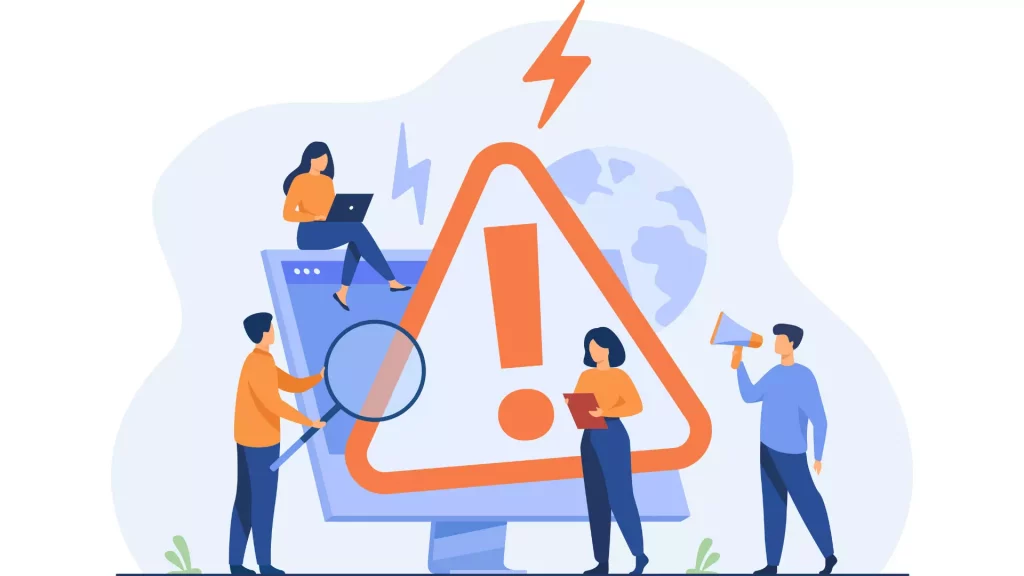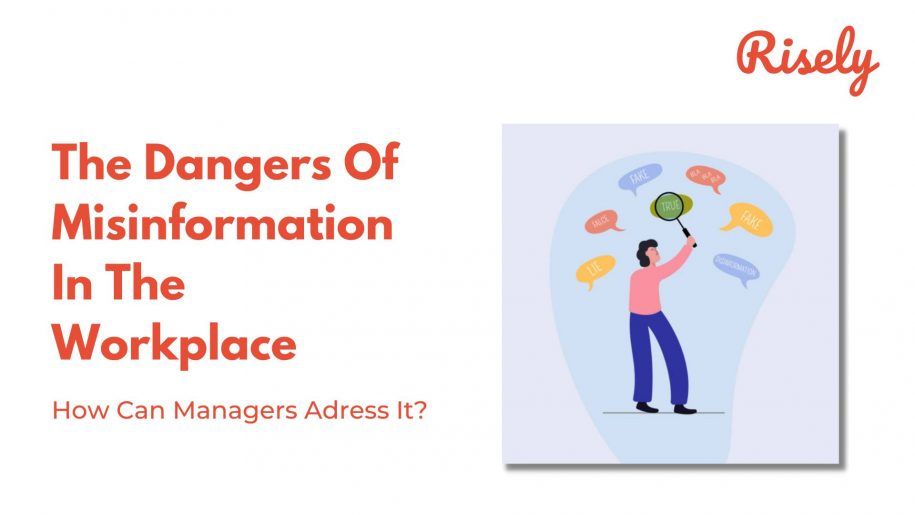The Dangers Of Misinformation In The Workplace: How Managers Can Address It?
Misinformation is a big problem in the workplace. Not only can it lead to misunderstandings and conflict, but it can also have severe consequences for the employees involved. In this article, we’ll discuss the dangers of misinformation and how managers can address it. We’ll also give you tips on reducing the chances of your employees being misled in the first place. So whether you’re a manager or an employee, read on to learn about the dangers of misinformation.What is Misinformation?
In its simplest form, misinformation is false or inaccurate information. It can be spread unintentionally by people who believe it to be accurate, or it can be spread deliberately by those who want to mislead others. Either way, it can severely impact workplace productivity and morale.How does it work: Tracking the Misinformation Effect
There are many ways that misinformation can spread in the workplace, such as through gossip, rumor, fake news, and false or inaccurate reports. It can also spread through social media like Facebook, Twitter, and other online channels. What is the misinformation effect? The misinformation effect is a psychological phenomenon first identified by psychologists Elizabeth Loftus and John C. Palmer. In an interesting study, volunteers were shown videos of traffic accidents. Now comes the surprising part: their memory of the event was impacted by the wording of questions used to test them later. Through clever sentences, the testers could add bits and pieces to the memories that actually did not happen, demonstrating how misinformation clings to truth and takes over slowly. It’s not about changing the exact facts; even how one presents it can change one’s understanding!Why is the misinformation effect important?
The impact of misinformation can be significant, causing lack of trust and confusion among employees and damaging the organization’s reputation. Here are two points to sum up the bigger picture:- In a survey of 25,000 individuals across 19 countries by Pew Research, misinformation stood as the second most critical concern for the planet.
- Edelman’s Trust Barometer places business as the last bastion of trust in an increasingly polarised world. Longstanding institutions like the government are losing the faith people once had in them.
The Dangers of Misinformation in the Workplace
Picture this: You are at work, and someone shared the wrong information with you. As a result, you wasted some time and energy and missed a deadline. What’s likely to follow?Hurt feelings and lost morale
In the fast-paced and ever-changing work world, misinformation is easy to spread. And when it does, it hurts feelings and reduces morale among employees. Misinformation can come from various sources, including rumors, office gossip, and even seemingly innocent comments made in passing. But whatever the source, misinformation can harm employees. For one, misinformation leads to misunderstandings and disagreements. It causes employees to feel defensive and resentful. Additionally, misinformation can cause employees to doubt their abilities and worth, leading to feelings of insecurity and self-doubt. Eventually, all of this can lead to lost morale and hurt feelings.Errors in judgment that can impact the your reputation
In today’s information-rich world, it’s easier than ever for employees to access data and make decisions based on that data. But what happens when the data employees base their decisions on is inaccurate? That problem can have severe repercussions for companies, as employees may make errors in judgment that can impact the company’s reputation.Frustration and conflict
Employees constantly bombarded with inaccurate information are more likely to experience frustration and conflict in their work lives. That is because misinformation can lead to confusion and disagreement about what is happening. It can also encourage employees to resist changes or new directions necessary for the company’s success. This constant tension can drive away talented staff members, leading to a decline in productivity. The remaining employees may end up with decreased satisfaction with their job and even dissatisfaction with their company.A hostile work environment
Misinformation creates a hostile work environment in several ways. First, it leads to employees feeling paranoid and un-trusting of one another. It can lead to fights and arguments and make it difficult for employees to work together. Second, misinformation has employees feeling in constant flux, as they constantly have to adjust their understanding of the workplace. It can lead to stress and anxiety, making it difficult for employees to focus on their work.Reduced productivity
Misinformation can quickly spread through the workplace, causing confusion and delays. In some cases, it can even lead to employee disengagement. All this together can cause a massive drop in productivity.
How can Managers Address Misinformation in the Workplace?
A workplace is a place where information is exchanged daily. As a manager, monitoring and preventing misinformation from spreading is essential. Here are five tips to help you do just that:Be vigilant in spotting misinformation and guard against it
Before acting on it, consider why misinformation spreads around your team. Is there a vacuum of information that you should be adequately willing with factual points? In case of lack of legit information, grapevines crop up and take the space. Or is there an intentional approach to spread misinformation at work and hamper the team? Managers need to be vigilant in spotting misinformation and guard against it. First, they should be aware of the signs that someone is spreading false information. It includes using misleading statistics or making outrageous claims without any evidence to back them up. You should also be familiar with the different ways that misinformation in the workplace can spread and should restrict them from occurring.Periodically disseminate information and allow the team to ask clarifying questions
Misinformation can quickly spread through a workplace, creating tension and confusion. To address this, it’s essential to have a process for disseminating information and allowing the team to ask clarifying questions. The process should have the following steps:- First, make sure that you have a clear and concise message that you want to get across. This message should be based on facts rather than emotions and should be communicated in a way that is easy to understand.
- Next, create a system for disseminating information. This system should include ensuring that all team members are aware of what’s going on and mechanisms for asking questions and getting clarification when needed.
- Finally, ensure that your team is trained in dealing with misinformation. They need to know how to identify incorrect information and ask questions to help them clarify what they’re trying to understand.
Make sure your communication is accurate and helpful to employees
Managers need to ensure that their communication is accurate and helpful to employees. It means providing clear and concise information that employees can understand easily. Further, the information should not be out of context and should be aligned entirely with or related to the work of those employees. By doing this, managers can help prevent misunderstandings and confusion. It will build a sense of trust among their employees. In turn, this will help foster a healthy work environment where everyone can excel.Avoid giving false or misleading information yourself
The best way to prevent misinformation is to be vigilant and truthful in your communication. Make sure you use correct terminology, be honest, avoid giving false or misleading information and make assumptions about someone else’s knowledge or understanding. Managers should also ensure that whatever information they put forward is fact-checked and that nothing or no part of it is questionable or untrue. All that is important because if managers themselves end up giving false or misleading information to their employees, it will take away the trust these employees have in their managers. Without that trust, making the best out of your team will be nearly impossible. On the other hand, if managers never resort to giving false or misleading information, it will set an example for the team. It will inspire the team to follow the lead and never resort to misinformation. What if things go wrong? Work on rebuilding trust: How To Rebuild Trust In The Workplace? 6 Tips For ManagersEducate your team on the importance of accurate information
Managers must ensure that their team is well-informed about the importance of accurate information. You can do this by setting up educational programs and distributing information materials. Additionally, you can take part in training sessions where they learn how to avoid giving false or misleading information themselves.A simple checklist to stop misinformation at work that you can share with your team can include three quick steps:
- Slow down and think before passing on the points
- Keep your emotions and biases aside
- Search for facts and evidence backing up what you are saying
Other Interesting Reads
Make sure all employees are aware of the dangers of spreading misinformation and enforce disciplinary action if necessary
It’s essential to ensure that all employees know the dangers of spreading misinformation in the workplace. Moreover, they should know the possible consequences they’ll face if they are found spreading misinformation of any kind. It will help to avoid any misunderstandings or conflicts, and it will also help to ensure that employees are following company policies and procedures. Further, if managers find that an employee is spreading false information, they should take appropriate disciplinary action. That may include issuing a warning, suspending the employee, or even firing them if necessary. In cases like this, it’s essential to ensure that an investigation is carried out so that the managers can take the correct measures.Conclusion
There is much information floating around the workplace that is not always true. This misinformation can hurt the morale of employees and their work performance. Therefore, to help managers address misinformation in the workplace, we’ve outlined the five dangers of misinformation and provided tips on addressing them. Follow the tips above and take action to ensure a healthy and informed workplace for everyone!Can you communicate smartly? Find out in five minutes.
Take the free effective communication assessment for managers to find the root of cause of issues bugging you every day.
FAQs
How can managers handle misinformation at work?
Managers can ensure that the communication mechanism is robust and people are allowed to interact freely to avoid the spread of misinformation at work.
What is the difference between misinformation and disinformation?
The difference between misinformation and disinformation lies in the intent. Misinformation happens to be incorrect by error, while the latter is purposefully wrong.
Other Related Blogs
Assertive Conflict Resolution Techniques | Brenda Hooper
Assertive Conflict Resolution Techniques | Brenda Hooper Can assertive communication help you out in resolving conflicts? In this podcast conversation, we have Brenda Hooper, an experienced executive coach joining us…
7 Conflict Resolution Scenarios At Work For Practice
7 Conflict Resolution Scenarios At Work For Practice Conflict resolution is one of the most important people management skills you must master. If conflicts on your team go unresolved, you…
Conflict Coach 101: A Beginner’s Guide
Conflict Coach 101: A Beginner’s Guide Did you know? Since 2008, we have doubled the hours we spend in conflicts at work. Research by the Myers-Briggs Company suggests that an…
5 Secrets To Conflict Resolution At Work For Managers
5 Secrets To Conflict Resolution At Work For Managers Conflict is all too common. We often encounter this ever-present demon in our workplaces, too. The trouble is manifold for managers…


